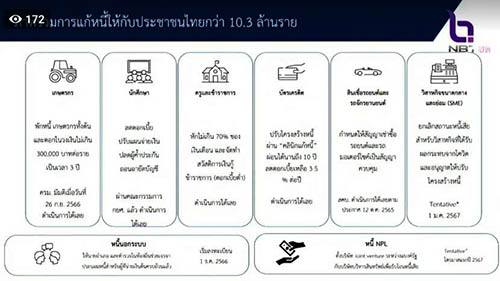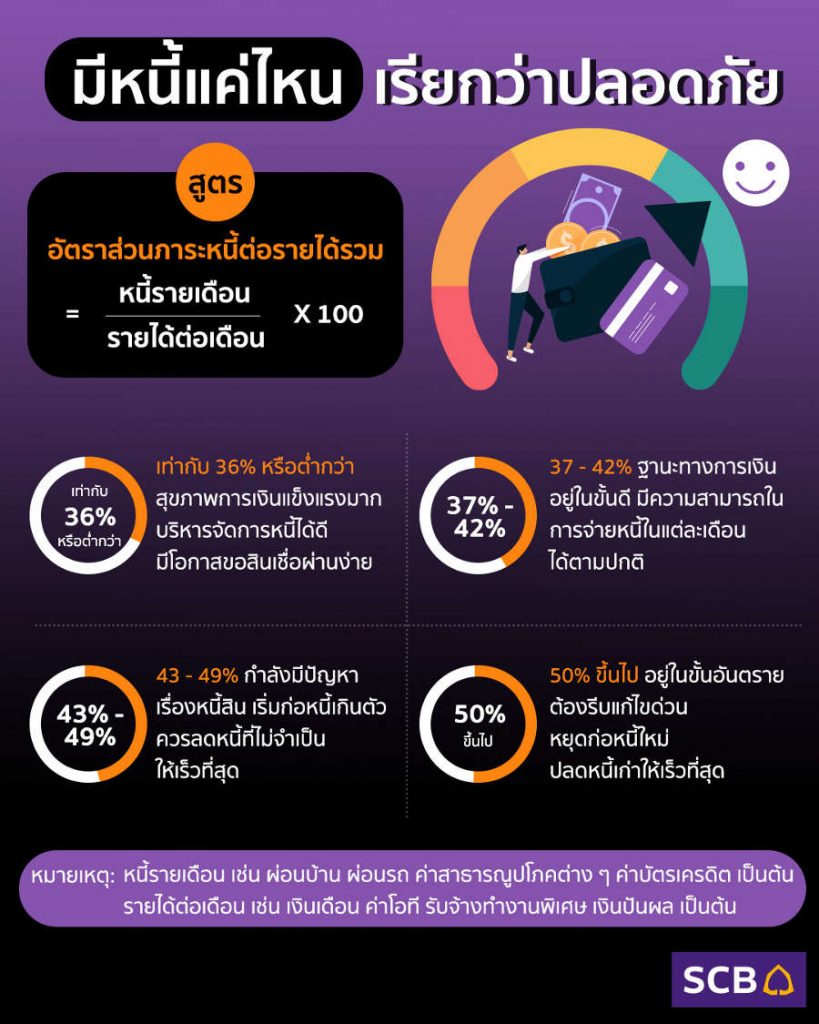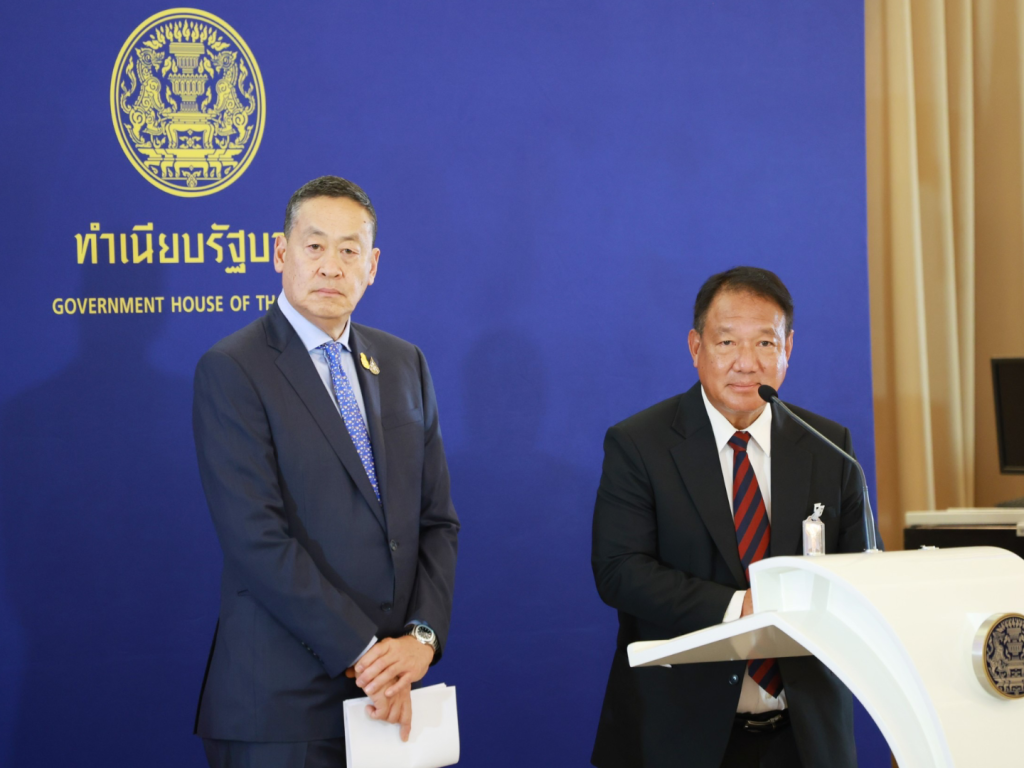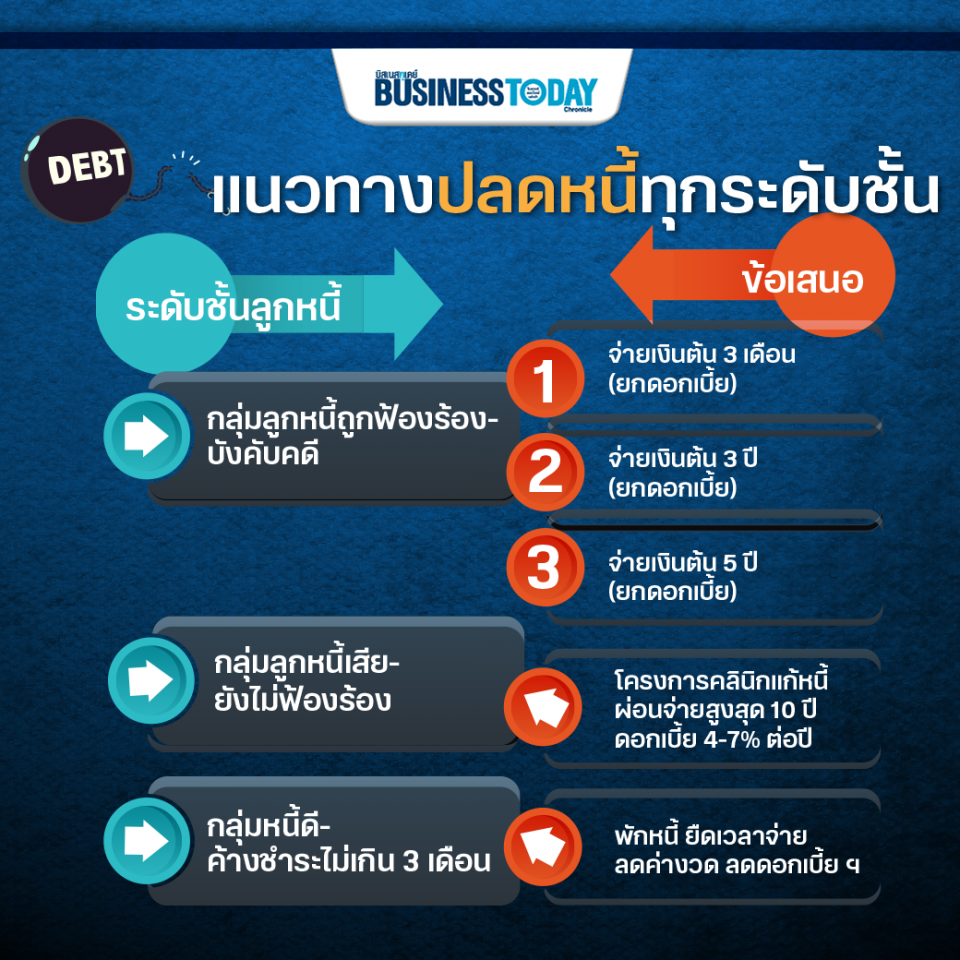
การจัดการหนี้ทั้งระบบ หนี้คนไทยมีมากกว่า 10.3 ล้าน ราย ปัญหาต้องจบในรัฐบาลนี้
นายเศรษฐา ทวีสิน นายกรัฐมนตรี และรมว.คลัง แถลงข่าวจัดการหนี้ทั้งระบบ โดยมีกฤษฎา จีนะวิจารณะ และจุลพันธ์ อมรวิวัฒน์ รัฐมนตรีช่วยว่าการกระทรวงการคลัง พร้อมผู้แทนหน่วยงานที่เกี่ยวข้องร่วมแถลง ประกอบด้วย ปลัดกระทรวงการคลัง ปลัดกระทรวงศึกษาธิการ ปลัดกระทรวงเกษตรและสหกรณ์ ผู้ว่าการธนาคารแห่งประเทศไทย เลขาธิการคณะกรรมการคุ้มครองผู้บริโภค ผู้อำนวยการสำนักงานเศรษฐกิจการคลัง ผู้จัดการกองทุนเงินให้กู้ยืมเพื่อการศึกษา ผู้อำนวยการธนาคารออมสิน ผู้จัดการธนาคารเพื่อการเกษตรและสหกรณ์ และนายกิตติรัตน์ ณ ระนอง ที่ปรึกษานายกรัฐมนตรีร่วมแถลง
นายกรัฐมนตรีกล่าวว่า ปัญหาหนี้สินเป็นปัญหาเรื้อรังที่อยู่กับสังคมไทยมายาวนาน ทั้งในส่วนของหนี้นอกระบบ ซึ่งรัฐบาลได้กำหนดให้ การแก้ไขปัญหาหนี้นอกระบบเป็นวาระแห่งชาติ ซึ่งได้แถลงไปแล้ว โดยหนี้ในระบบ ซึ่งก็มีปัญหาไม่แพ้กับหนี้นอกระบบ ทั้งหนี้สินล้นพ้นตัว จนส่งผลกระทบต่อการทำงาน บางรายเป็นหนี้เสียคงค้างเป็นเวลานาน จนขาดโอกาสในการประกอบอาชีพ ดังนั้น การดูแลลูกหนี้ในระบบที่ประสบปัญหาจึงถือเป็นวาระแห่งชาติเช่นเดียวกัน ตนจึงมอบนโยบายให้หน่วยงานที่เกี่ยวข้อง และขอความร่วมมือจากทุกภาคส่วน ให้มาร่วมกันแก้หนี้ทั้งระบบให้จบภายในรัฐบาลนี้ ควบคู่ไปกับการร่วมกันสำรวจและซ่อมแซมกลไกทางเศรษฐกิจ เพื่อทำให้เครื่องจักรทางเศรษฐกิจเราทำงาน เติบโต และขยายตัวต่อไปได้
ทางด้านนายกิตติรัตน์ กล่าวว่า ตัวเลขหนี้ที่นายกรัฐมนตรีแถลงในวันนี้คิดเป็นมูลหนี้ประมาณ 16 ล้านล้านบาท หรือคิดเป็นประมาณ 90% ของผลิตภัณฑ์มวลรวมในประเทศ (จีดีพี) และครอบคลุมประชากรประมาณ 5 ล้านคน 12 ล้านบัญชีที่มีปัญหาไม่สามารถชำระหนี้ได้ ซึ่งในส่วนนี้รวมทั้งหนี้ของสถาบันการเงิน หนี้สหกรณ์ และหนี้กองทุนเพื่อการกู้ยืม เพื่อการศึกษา (ก.ย.ศ.) ด้วย ซึ่งในส่วนของหนี้บัตรเครดิตที่เริ่มมีปัญหานั้นอยู่ที่ประมาณ 1 ล้านใบ จาก 23 ล้านใบที่มีอยู่ ที่มีมาตรการออกมาในการแก้ปัญหาโดยการเข้าโครงการลดดอกเบี้ยลงเหลือ 3 – 5% สำหรับคนที่ไม่มีกำลังจ่ายได้
กล่าวโดยรวมการแก้ปัญหาหนี้สินเป็นปัญหาเรื้อรังที่อยู่ในสังคมไทยมายาวนานทั้งในส่วนของหนี้นอกระบบซึ่งรัฐบาลได้กำหนดการแก้ไขปัญหาหนี้นอกระบบเป็นวาระแห่งชาติตามที่ได้แถลงนโยบายไว้ต่อรัฐสภาเมื่อวันที่ 28 พ.ย.ที่ผ่านมา และอีกครั้งเมื่อวันที่ 8 ธันวาคมที่ผ่านมา ทั้งนี้หนี้ในระบบซึ่งมีปัญหาไม่แพ้หนี้นอกระบบซึ่งส่งผลกระทบต่อการทำงาน บางรายเป็นหนี้เสียคงค้างเป็นเวลานานจนขาดโอกาสในการประกอบอาชีพ ดังนั้น การดูแลลูกหนี้ในระบบที่ประสบปัญหาจึงถือเป็นวาระแห่งชาติ โดยรัฐบาลจะให้ความสำคัญในการแก้ไขปัญหาหนี้ทั้งระบบ ทั้งการจัดการกวาดล้างหนี้นอกระบบ และการดูแลลูกหนี้ในระบบให้ได้รับสินเชื่ออย่างเหมาะสมและเป็นธรรม การมีลูกหนี้ที่ดีเป็นกลไกสำคัญในการขับเคลื่อนเศรษฐกิจของประเทศโดยรวม อย่างไรก็ดี จากสภาพเศรฐกิจในช่วงที่ผ่านมาทำให้กลไกต่างๆ ติดขัดหลายประการด้วยกันจนปัญหาสั่งสมมาใหญ่จนเกิดจะแก้ไขได้โดยปราศจากการช่วยเหลือจากภาครัฐ ทั้งนี้ ขอแบ่งกลุ่มลูกหนี้ที่ประสบปัญหาออกเป็น 4 กลุ่ม ดังนี้
กลุ่มที่ 1 คือ ลูกหนี้ที่ได้รับผลกระทบจากโควิด
กลุ่มที่ 2 คือ กลุ่มลูกหนี้ที่มีรายได้ประจำแต่มีภาระหนี้จำนวนมาก
กลุ่มที่ 3 คือ กลุ่มลูกหนี้ที่มีรายได้ไม่แน่นอนทำให้เกิดการชำระหนี้ไม่ต่อเนื่อง
กลุ่มที่ 4 คือ กลุ่มลูกหนี้ที่เป็นหนี้เสียคงค้างเป็นระยะเวลายาวนาน
ทั้งนี้ ทั้ง 4 กลุ่มมีข้อสังเกตประการหนึ่ง คือ ไม่สามารถผ่อนชำระหนี้ได้จนกระทั่งกลายเป็นหนี้เสียจึงถูกเรียกดอกเบี้ยปรับเพิ่มและวนกลับไปทำให้ชำระไม่ไหวส่งผลให้ติดเครดิตบูโรไม่สามารถขอสินเชื่อในระบบต่อได้ บางรายค้างชำระเป็นเวลานานก็จะถูกดำเนินการตามกฎหมายอย่างไรก็ดี มีต้นตอที่แตกต่างกัน รัฐบาลจึงเตรียมแนวทางเพื่อช่วยเหลือที่แตกต่างกัน ดังนี้
กลุ่มที่ 1 คือ ลูกหนี้ที่ได้รับผลกระทบจากโควิด
สำหรับลูกหนี้กลุ่มนี้มีประวัติการชำระหนี้ดีมาตลอดแต่จากสถานการณ์โควิดทำให้ธุรกิจต้องสะดุดหยุดลง ขาดสภาพคล่องจนไม่สามารถชำระคืนหนี้ได้ สำหรับลูกหนี้รายย่อยซึ่งส่วนใหญ่มีหนี้เสียกับธนาคาร ธ.ก.ส.และออมสิน รัฐบาลกำหนดให้ธนาคารทั้งสองแห่งติดตามทวงถามหนี้ตามสมควรและให้ความช่วยเหลือแก่ลูกหนี้กลุ่มนี้เพื่อไม่ให้เป็นหนี้เสียอีกต่อไป โดยคาดว่าจะช่วยเหลือลูกหนี้รายย่อยกลุ่มนี้ได้ประมาณ 1.1 ล้านราย ส่วนลูกหนี้เอสเอ็มอี สถาบันการเงินของรัฐจะเข้าไปช่วยเหลือผ่านการปรับปรุงโครงสร้างหนี้และพักชำระหนี้ให้ลูกหนี้เอสเอ็มอีที่อยู่กับแบงก์รัฐทั้งบุคคลธรรมดา และนิติบุคคล เป็นเวลา 1 ปี โดยคาดว่าจะช่วยเหลือลูกหนี้เอสเอ็มอีกลุ่มนี้ได้ครอบคลุมมากกว่า 99 % ของจำนวนลูกหนี้ที่เป็นหนี้เสียในกลุ่มนี้นับเป็นจำนวนกว่า 1 แสนราย
กลุ่มที่ 2 คือ กลุ่มลูกหนี้ที่มีรายได้ประจำแต่มีภาระหนี้จำนวนมากจนเกินศักยภาพ
1. กลุ่มลูกหนี้ที่มีรายได้ประจำแต่มีภาระหนี้จำนวนมากจนเกินศักยภาพ แบ่งออกเป็น 2 กลุ่ม ดังนี้
1. กลุ่มข้าราชการ ตำรวจ ครู และทหาร ที่มักจะมีหนี้กับสถาบันการเงิน กลุ่มนี้จะได้รับการช่วยเหลือผ่าน 3 แนวทาง คือ
แนวทางแรก คือ ลดดอกเบี้ยสินเชื่อไม่ให้สูงจนเกินไปเพราะเป็นกลุ่มที่มีรายได้ประจำและถือว่ามีความเสี่ยงต่ำ
แนวทางที่สอง คือ จะต้องโอนหนี้ทั้งหมดไปไว้ในที่เดียว อาทิ สหกรณ์ เพื่อให้การตัดเงินเดือนมาชำระหนี้ทำได้สะดวกและสอดคล้องกับรายได้ของลูกหนี้
แนวทางสุดท้าย คือ บังคับใช้หลักเกณฑ์การตัดเงินเดือนเพื่อให้ลูกหนี้มีเงินเดือนเหลือต่อการดำรงชีพอย่างมีศักดิ์ศรี โดยทั้ง 3 แนวทางต้องทำพร้อมกันทั้งหมด
2. กลุ่มที่เป็นหนี้บัตรเครดิตและสินเชื่อส่วนบุคคล ปรับโครงสร้างหนี้ผ่าน “คลินิกแก้หนี้” debtclinibysam.com โดยสามารถผ่อนได้นานถึง 10 ปี ลดดอกเบี้ยเหลือร้อยละ 3-5 ต่อปี
กลุ่มที่ 3 กลุ่มผู้มีรายได้ไม่แน่นอนทำให้การชำระคืนหนี้ไม่ต่อเนื่อง
กลุ่มนี้จะได้รับการพักชำระหนี้เป็นการชั่วคราว การลดดอกเบี้ย หรือลดเงินผ่อนชำระในแต่ละคนให้ต่ำลง เพื่อให้สอดคล้องกับรายได้ของหนี้ เช่น ลูกหนี้เกษตรกร รัฐบาลมีโครงการพักชำระหนี้ให้เกษตรกรโดยถ้วนหน้า โดยพักทั้งหนี้เงินต้นและดอกเบี้ยเป็นเวลา 3 ปี มีเกษตรกรเข้าร่วมพักหนี้แล้วกว่า 1.5 ล้านราย, ลูกหนี้ กยศ. บางส่วนยังไม่มีงานทำ ได้มีการปรับโครงสร้างหนี้ ลดดอกเบี้ย ลดเบี้ยปรับ และเปลี่ยนลำดับการตัดชำระหนี้, ลูกหนี้เช่าซื้อรถยนต์ หรือ รถมอเตอร์ไซต์ สำนักงานกรรมการคุ้มครองผู้บริโภคได้ออกประกาศเพื่อกำหนดอัตราดอกเบี้ยเช่าซื้อ เช่น กรณีเช้าซื้อรถใหม่ต้องคิดดอกเบี้ยไม่เกินร้อยละ 10 ต่อปี กรณีรถจักรยานยนต์ต้องไม่เกินร้อยละ 23 ต่อปี และลดดอกเบี้ยผิดนัดชำระให้ต่ำลง รวมทั้งให้ส่วนลดหากลูกหนี้สามารถปิดบัญชีได้ก่อนกำหนด
นอกจากนี้กระทรวงการคลังได้ร่วมกับธนาคารแห่งประเทศไทย และ สคบ.อยู่ระหว่างปรับแนวทางการดูแลธุรกิจเช่าซื้อให้เข้มข้นมากยิ่งขึ้นเพื่อคุ้มครองผู้บริโภคด้วย
กลุ่มที่ 4 กลุ่มหนี้เสียคงค้างกับธนาคารเป็นเวลานาน
กลุ่มนี้จะโอนไปยังบริษัทบริหารสินทรัพย์ซึ่งเกิดจากการร่วมทุนกับสถาบันการเงินของรัฐและบริษัทบริหารสินทรัพย์เพื่อจะทำให้การปรับปรุงโครงสร้างหนี้ให้กับลูกหนี้เป็นไปอย่างคล่องตัวมากขึ้น คาดว่ามาตรการนี้จะช่วยเหลือลูกหนี้ได้ประมาณ 3 ล้านราย อย่างไรก็ตาม ทั้งหมดนี้เป็นเพียงการแก้ปัญหาที่ปลายเหตุในระยะเร่งด่วนเพื่อต่อลมหายใจให้กับลูกหนี้ทุกคน ในระยะยาวควรมีการแก้ปัญหาในระดับโครงสร้างโดยยกระดับให้บริการสินเชื่อให้เหมาะสมและเป็นธรรมโดยกระทรวงการคลังได้ร่วมกับหน่วยงานที่เกี่ยวข้องจัดทำแนวทางเพื่อยกระดับการให้สินเชื่อและการค้ำประกันสินเชื่อให้สะท้อนความเสี่ยงของลูกหนี้ได้มากขึ้น รวมทั้งมีมาตรการคุ้มครองผู้บริโภคที่เหมาะสมและป้องกันปัญหาการก่อหนี้ เช่น หลักเกณฑ์การให้สินเชื่ออย่างรับผิดชอบและเป็นธรรม โดย ธปท.กำหนดให้สถาบันการเงินกำหนดอัตราดอกเบี้ยตามความเสี่ยงของลูกหนี้ และกำหนดให้การผ่อนชำระสินเชื่อต้องให้ผู้กู้ยืมเงินเหลือเพียงพอต่อการดำรงชีพ รวมถึงการพิจารณาข้อมูลอื่นนอกจากประวัติการให้สินเชื่อ เช่น ประวัติการชำระค่าน้ำ ค่าไฟ การผลักดันให้สหกรณ์ออมทรัพย์และสหรกรณ์เครดิยูเนี่ยนรายงานข้อมูลไปยังเอ็นซีบี เพื่อให้ผู้ให้สินเชื่อประเมินความสามารถในการชำระหนี้ของลูกหนี้ได้และการจัดการบุริมสิทธิในการตัดเงินเดือนของลูกหนี้ที่เป็นหนี้เพื่อชำระหนี้ได้อย่างเหมาะสม เป็นต้น
นอกจากนี้กลุ่มลูกหนี้ที่มีปัญหาเรื้อรัง ธปท.กำหนดให้เจ้าหนี้ต้องปรับปรุงโครงสร้างหนี้ในการชำระ รวมทั้งปรับลดอัตราดอกเบี้ยและค่าธรรมเนียมต่าง ๆ รวมกันไม่เกินร้อยละ 15 ต่อปี และจบหนี้ให้ได้ภายใน 5 ปี ในตอนท้ายนายเศรษฐา นายกรัฐมนตรีและรมว.คลังประกาศย้ำว่า การแก้ปัญหาหนี้ต้องแก้ให้จบภายในรัฐบาลชุดนี้






Debt management throughout the system. Thai debts account for more than 10.3 million cases. The problem must end in this government. (THAI/ENG)
Mr. Setha Thaweesin, Prime Minister and Minister.Finance Minister Krisada Jinavicharana and Deputy Finance Minister Chulaphan Amornwiwat joined the press conference, including Permanent Secretary of Ministry of Finance, Permanent Secretary of Ministry of Education, Permanent Secretary of Ministry of Agriculture and Cooperatives. Mr. Kittirat Na Ranong, Advisor to the Prime Minister of Thailand, President and CEO of the Bank for Agriculture and Cooperatives, and Mr. Kittirat Na Ranong.
Prime Minister Abhisit Vejjajiva said that debt problems have long been a chronic problem for Thai society, both in the informal sector and in the government’s national agenda. Debt in the system, which is as much as external debt, has been overflowing and has affected some people’s work for a long period of time and lack career opportunities. Therefore, it is also a national agenda to take care of debtors in the troubled system. He asked related agencies to cooperate with all sectors to complete debt restructuring within this government. At the same time, we will also explore and repair economic mechanisms to make our economic machines work, grow and expand.
Mr. Kittirat said that the prime minister’s debt today amounted to around 16 trillion baht, or about 90% of the GDP and covers a population of 5 million 12. Millions of accounts that have been unable to repay their debts, including those of financial institutions, cooperative debt and student loan funds (A.In addition, the number of credit card debts that have started to be problematic is about 1 million out of the 23 million cards that have been issued as a measure to solve this problem. The interest rate reduction program will be reduced to 3-5% for those who are not able to afford it.
Overall, debt resolution has been a long-standing problem in Thai society, both in informal debt and the government’s agenda for solving informal debt problems as a policy statement issued to Parliament on 28 May.Last year and again on December 8th. Some of the outstanding debts that have affected their work have been lost for a long period of time. Therefore, the government will focus on solving debt problems throughout the system, including clearing up non-performing loans. And proper and fair management of debtors in the system. Having good debtors is an important mechanism to drive the country’s overall economy.Due to the recent economic conditions, many mechanisms have been disrupted until the problem is solved without government assistance. The debtors who are suffering from this problem will be divided into 4 groups as follows:
Group 1 is the debtor affected by Covid.
The second is the group of debtors with fixed income but with a large debt burden.
The third group is the group of debtors whose income is uncertain, causing them to be unable to repay their debts continuously.
The fourth group is the group of debtors who have been outstanding in bad debts for a long period of time. In this regard, all four groups have one observation: Unable to repay debt until it becomes a bad debt, the interest rate is increased and the loan cannot be paid back. As a result, the credit system cannot continue to apply for loans. Some of these outstanding debts will be legalized.Well, there are different origins. Therefore, the government has prepared different ways to help as follows:
Group 1 is the debtor affected by Covid.
These debtors have a good track record of repaying their debts, but the Covid situation has caused businesses to stumble, lack liquidity, and unable to repay debts. Most of them have bad debts with BAY.GSB and GSB. The government has set up two banks to seek appropriate debt collection and provide assistance to these debtors so that they can no longer be bad debts. It is expected to help this group of small debtors approximately 1.One million SME debtors, state-owned financial institutions, will help through debt restructuring and debt restructuring for one year. This group is expected to cover more than 99% of the 100,000 debtors in this group.
The second group is The group of debtors with fixed income but with a large debt burden that exceeds their potential.
1. The groups of debtors with fixed income but with debt burdens exceeding their potential are divided into two groups as follows:
1. This group of government officials, police, teachers and soldiers who often have debts with financial institutions will be helped through three ways:
The first approach is to reduce interest rates on loans from high levels because they are those with low-risk fixed income.
The second approach is to transfer all debts into one place, such as cooperatives. In order to facilitate the repayment of salaries in line with the income of debtors.
The last approach is to enforce salary cuts in order to ensure that debtors have a decent living wage. All three guidelines must be followed at the same time.
2. Credit card debt and personal loans debt restructuring group through “debtclinibysam” debt resolution clinic.The com offers 10-year instalments with interest rates of 3-5 percent per annum.
The third group,
the group with uncertain income, has caused the repayment of debt to be discontinued.
This group will receive temporary suspension of debt repayment, interest reduction or reduced instalment payments for each individual in order to match the income of debts such as farmers’ debtors. With both principal and interest receivables suspended for three years, more than 1.5 million farmers joined the debt restructuring program, debtors. Some of them are still unemployed. There have been debt restructuring, interest reduction, fines and other changes in the order in which they were eliminated. The Consumer Protection Commission (CRC) has issued a notice to set interest rates such as 10 percent per annum for new cars, 23 percent per annum for motorcycles, and lower delinquency rates and discounts if debtors close their accounts early.
In addition, the Ministry of Finance has cooperated with the Bank of Thailand and the Association.At the same time, it is in the process of intensifying its management of the hire purchase business to protect consumers.
Group 4 The group of bad debts outstanding with banks for a long time.
This group will be transferred to asset management companies formed by joint ventures with state-owned financial institutions and asset management companies to facilitate debt restructuring for debtors. It is expected that this measure will help approximately 3 million debtors.All of these are urgent solutions to all debtors. In the long run, structural problems should be addressed by improving loan service to be appropriate and fair. The Ministry of Finance and related agencies have established guidelines to improve credit and credit guarantees to reflect debtors’ risk. As well as appropriate consumer protection measures to prevent debt problems, e.g., the Bank of Thailand’s responsible and fair lending rules.Financial institutions must set interest rates according to the risk of debtors and loan repayment requirements, including information other than credit history such as the history of water bills, electricity bills and credit unions to report to NCB. To allow lenders to assess the debtor’s debt repayment ability and appropriately manage the right to write-off salaries of debtors in order to repay debts, etc.
In addition, the Bank of Thailand (BOT) has a chronic problem with debtors.Creditors are required to improve their debt repayment structure, reduce interest rates and fees by not more than 15 percen And finish the debt within 5 years at the end of Mr. Setha, Prime Minister and Minister.The Treasury announced that the debt problem must be solved within this government….







